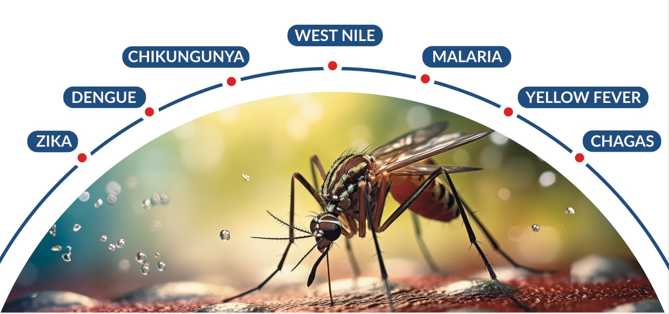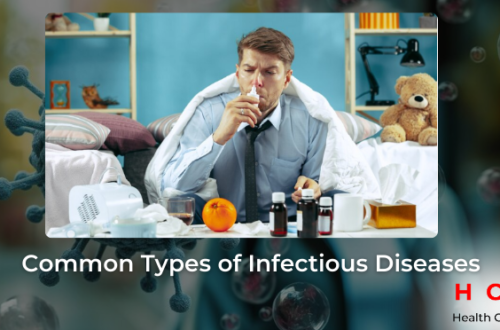
Understanding Common Infectious Diseases: Types, Symptoms, and Prevention
These include many of the most significant infectious Common Infectious Diseases to impact health on the global scene. Most infectious diseases are caused by pathogens: viruses, bacteria, fungi, and parasite species having their specificity. Some may be mild as a weakness; others can be life-threatening if left untreated in time.
This section delves deeper into the most common forms of infectious diseases, their symptoms, modes of transmission, and prevention techniques. Whether it is a viral infection such as influenza, a bacterial disease like tuberculosis, or a parasitic infection such as malaria, a better understanding probably exists that will help in effective prevention and treatment.

Viral Infections
Viruses are perhaps the most prevailing infectious disease. Viruses can be so benign that a person will have a low-grade infection, and sometimes viruses can be serious enough to endanger the patient’s life. Among the most common viral infections include:
Influenza (Flu):
A highly contagious respiratory infection spreads through droplets when an infected person coughs or sneezes. It comprises fever, body aches, and even fatigue. Annual vaccination and hygiene practices are major prevention strategies.
COVID-19 This has been the global pandemic of recent times. COVID-19 has been caused by SARS-CoV-2 virus. It is a respiratory disease affecting from slight coughs to severe pneumonia. Masks, vaccinations, and maintaining social distance are critical preventive measures.
Hepatitis B and C:
These have been known to cause infections in the liver and place individuals at high risks of chronic disease in the liver. The affected individuals can acquire these viruses from others through blood contact, shared needles, and sexual contact. While antiviral drugs are available for Hepatitis C, a vaccine prevents Hepatitis B.
HIV/AIDS:
HIV weakens the immune system. If left to its course, the disease eventually progresses into AIDS. There is a route of infection through blood exposure or sexual contact, but there’s also vertically from mother to child at birth. Antiretroviral drugs are used in the treatment of the infection. Nowadays the term “bacterial infections” is used to describe a host of conditions caused by bacteria. Most bacterial infections involve minor skin conditions but some may have more significant attacks in the internal organs. Some common bacterial infections include:

Tuberculosis:
TB is a health-related concern globally. Most of the time, it targets the lungs, and the way the infections spread into the human body primarily occurs via airborne droplets. Common symptoms of patients suffering from tuberculosis include chronic coughing, chest pain, and weight loss. Treatment includes a long course of antibiotics with proper vaccination to avoid serious cases.
Strep Throat:
Caused by the Streptococcus bacteria, this is one of the most common illnesses of childhood. Such infections include symptoms like sore throat, fever, and swollen lymph nodes. It should be treated with antibiotics to prevent rheumatic fever.
Urinary Tract Infections (UTIs):
Very common, especially in women, UTIs are infections of the urinary tract resulting from the entry of bacteria. Symptoms include a burning sensation while urinating, pain, and frequent urination. UTIs are treated with antibiotics and good hygiene measures.
Fungal Infections
Fungal infections range from mild disorders such as athlete’s foot to severe systemic infections of immunocompetent subjects. Among the common fungal infections include:
Athlete’s Foot:
This is a fungal infection that thrives in warm, moist environments and leads to terrible itchy skin rash on the feet. Management of this infection entails antifungal medications and proper hygiene of the feet.
Malaria:
A huge health problem in the tropics, it results from the bite of infected mosquitoes, causing fever, chills, and flu-like illness. Preventive methods include mosquito nets and antimalarial medications.

Toxoplasmosis
This is a disease that results from the parasite Toxoplasma gondii. This condition mostly results from undercooked meat or contaminated water. It can pose severe risks to pregnant women as well as to those whose immune systems are susceptible to opportunistic infections.
Methods of Transfer and Prevention
There are various ways infectious diseases are transmitted from one person to another. These methods include:
Direct Contact :
The actual infection directly comes through physical contact, sexual contact, or mother to child.
Airborne Transmission:
Infections like influenza and tuberculosis are transferred through droplets suspended in the air when an infected person coughs or sneezes.
Diseases Spread Through Food and Water Contamination:
Food-borne diseases together with waterborne diseases could be cholera or hepatitis A.
Vector-Transmitted:
Such diseases include malaria, vectored by mosquitoes that carry the infection from host to host.

Vaccination:
Many infectious diseases such as measles, polio, and hepatitis can be prevented through vaccination. Vaccination is one of the best methods to control an outbreak.
Good Hygiene Practices:
Keeping hygiene with frequent hand washing, application of hand sanitizers, and also not touching the face is all that can prevent the spreading of many infectious diseases.
The third type is vector control which prevents infections like malaria and dengue by using nets and repellents, getting rid of standing water, and so on.

Conclusion
Along with prevention measures, people should understand infectious diseases, along with their causes. If left untreated, they can result in a devastating form of infectious diseases caused by viruses, bacteria, fungi, or parasites. Many of these diseases could be prevented if the right knowledge and preventive measures were used.
For more tips on the most common infectious diseases, check out the resource here. Stay informed, stay safe, and take steps to protect yourself and others from infectious diseases.


